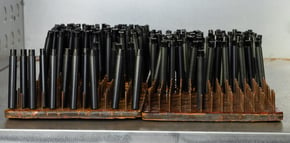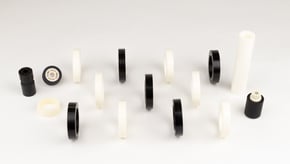Polyurethane Temperature Range
One of many common questions we often receive from product designers is "What temperature range can polyurethane withstand?". Depending on the chemistry, thermoset polyurethanes can typically withstand a wide range of temperatures, unlike thermoplastics and rubber. From arctic tundras to dry, hot deserts, this customizable material can often maintain its original shape and physical properties even in the harshest conditions. However, there are a few conditions designers must consider while designing with thermoset polyurethane. In this post, we will discuss the importance of temperature range in your design and how it can potentially affect your product's performance.
Temperature Range
Standard thermoset polyurethanes can typically withstand temperatures between -80°F to 200°F. However, some polyurethane chemistries can have a higher tolerance to temperature, as high as 300°F. Outside of these temperatures, thermoset polyurethanes will tend to weaken or degrade over time.
Operating Temperatures
 Operating temperatures typically refer to the range of temperature that a material can withstand, while successfully performing its role in an operation. In other words, it's not just about surviving the temperature, but instead, executing a task in that temperature. As such, operating temperatures will be defined by the application's environment, as well as the length of exposure to that environment. When making a material choice, it is very important to validate the physical properties that will not be compromised under the expected environmental conditions, during operation.
Operating temperatures typically refer to the range of temperature that a material can withstand, while successfully performing its role in an operation. In other words, it's not just about surviving the temperature, but instead, executing a task in that temperature. As such, operating temperatures will be defined by the application's environment, as well as the length of exposure to that environment. When making a material choice, it is very important to validate the physical properties that will not be compromised under the expected environmental conditions, during operation.
Luckily, thermoset polyurethanes come in many shapes and forms. Depending on the chemical composition of the material's backbone, a designer can often have the flexibility to specify a wide range of operating temperatures. For example, TDI-backed polyurethanes tend to have higher operating temperature ranges, than MDI-backed polyurethanes. Take Durethane XL as an example, this powerful material was engineered with a poly-carbonate backbone to perform in the harshest conditions.
High Temperatures
 When thermoset polyurethanes are exposed to temperatures above their range for long periods of time, this can often lead to the following conditions:
When thermoset polyurethanes are exposed to temperatures above their range for long periods of time, this can often lead to the following conditions:
- Weakened physical properties
- Material may revert, turning sticky
- Material may burn, depending on temperature and exposure to flame
Low Temperatures
Applications with long-term operating temperatures below -0°F can stiffen the urethane, altering the material's physical properties. Temperatures lower than -80°F will turn the material brittle, therefore, increase the likelihood of tearing and/or ripping apart.
Conclusion
Thermoset polyurethanes can be custom formulated to meet the toughest applications. From almost an endless range of physical properties, consisting of either a dual durometer, conductive, flame, and/or abrasion resistant properties - we can custom formulate it all! To learn more about our high-performance materials for improved performance, download our material data sheet, here, or click the banner below:




